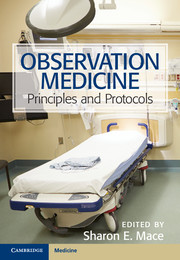Book contents
- Observation Medicine
- Observation Medicine
- Copyright page
- Contents
- Advance Praise
- About the Editors
- Contributors
- Foreword: Onward and Upward
- Preface
- Part I Administration: Key Concepts of Observation Medicine, and Developing and Maintaining an Observation Unit
- Part II Observation Medicine: Clinical Setting and Education
- Part III New Developments in Observation Medicine
- Part IV Clinical
- Part V Financial
- Part VI International
- Part VII Evidence Basis for Observation Medicine
- Part VIII Clinical Protocols
- Part IX Administrative Policies
- Part X Order Sets
- Prologue
- Index
- References
Part X - Order Sets
Published online by Cambridge University Press: 31 March 2017
- Observation Medicine
- Observation Medicine
- Copyright page
- Contents
- Advance Praise
- About the Editors
- Contributors
- Foreword: Onward and Upward
- Preface
- Part I Administration: Key Concepts of Observation Medicine, and Developing and Maintaining an Observation Unit
- Part II Observation Medicine: Clinical Setting and Education
- Part III New Developments in Observation Medicine
- Part IV Clinical
- Part V Financial
- Part VI International
- Part VII Evidence Basis for Observation Medicine
- Part VIII Clinical Protocols
- Part IX Administrative Policies
- Part X Order Sets
- Prologue
- Index
- References
Summary

- Type
- Chapter
- Information
- Observation MedicinePrinciples and Protocols, pp. 601 - 765Publisher: Cambridge University PressPrint publication year: 2017
References
References
References
References
References
Reference
** Activity depends upon clinical situation. Consider physical therapy as indicated. Encourage ambulation whenever possible. A swallowing screen can be done on patients prior to PO intake. The option for unlimited sodium in the diet can be deleted to promote a decreased sodium intake as part of control for hypertension. Check for diabetes and hypercholesterolemia, and counsel for smoking cessation, which are treatable risk factors for stroke and TIA. Consider consult with internal medicine/family practice regarding initiation of treatment for diabetes and hypercholesterolemia. Neurology consult is recommended for patients with TIA and stroke. The TIA order set can be customized from our template by stressing certain key factors.
*** Consider hypercoagulation panel if patient has strong family history of clotting disorders (such as deep vein thrombosis [DVT] or pulmonary emboli [PE]) and/or is young and has no risk factors for DVT yet has a DVT or PE. The coagulation panel includes such tests as protein S, protein C, antithrombin III, and factor VIII; and is a screen for inherited clotting disorders. It is expensive and thus, should be done only when there is a suspicion for an inherited disorder being present.

